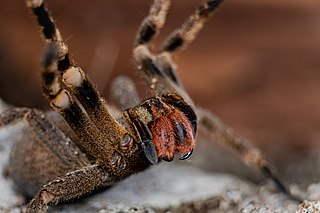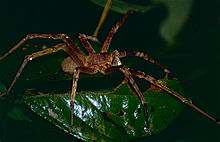
Phoneutria is a genus of spiders in the family Ctenidae. They are mainly found in northern South America, with one species in Central America. Members of the genus are commonly referred to as Brazilian wandering spiders. Other English names include armed spiders and banana spiders.

Atracidae is a family of mygalomorph spiders, commonly known as Australian funnel-web spiders or atracids. It has been included as a subfamily of the Hexathelidae, but is now recognized as a separate family. All members of the family are native to Australia. Atracidae consists of three genera: Atrax, Hadronyche, and Illawarra, comprising 35 species. Some members of the family produce venom that is dangerous to humans, and bites by spiders of six of the species have caused severe injuries to victims. The bites of the Sydney funnel-web spider and northern tree-dwelling funnel-web spider are potentially deadly, but no fatalities have occurred since the introduction of modern first-aid techniques and antivenom.

Wandering spiders (Ctenidae) are a family of spiders that includes the Brazilian wandering spiders. These spiders have a distinctive longitudinal groove on the top-rear of their oval carapace similar to those of the Amaurobiidae. They are highly defensive and venomous nocturnal hunters. Wandering spiders are known to hunt large prey, for example hylid species Dendropsophus branneri. Despite their notoriety for being dangerous, only a few members of Phoneutria have venom known to be hazardous to humans, but the venoms of this family are poorly known, so all larger ctenids should be treated with caution.

A spider bite, also known as arachnidism, is an injury resulting from the bite of a spider. The effects of most bites are not serious. Most bites result in mild symptoms around the area of the bite. Rarely they may produce a necrotic skin wound or severe pain.
Phoneutria bahiensis is a species of spiders in the family Ctenidae, found in Brazil. It's known in Brazilian Portuguese as Armadeira da Bahia,.

Phoneutria boliviensis is a species of a medically important spider in the family Ctenidae found in Central and South America.

Phoneutria nigriventer is a species of medically significant spider in the family Ctenidae, found in the Southern Cone of South America. Along with other members of the genus, they are often referred to as Brazilian wandering spiders.
Phoneutria reidyi is a species of venomous spiders in the family Ctenidae, found in South America.

Ancylometes is a genus of Central and South American semiaquatic wandering spiders first described by Philipp Bertkau in 1880. Originally placed with the nursery web spiders, it was moved to the Ctenidae in 1967. The genus name is derived in part from Ancient Greek "ἀγκύλος", meaning "crooked, bent".
Tx2-6 is a toxin found in the venom of the Brazilian wandering spider, Phoneutria nigriventer(Keyserling). It is a peptide of 48 residues, molecular weight 5291.3. This peptide is cleaved from a longer precursor with a signal peptide and a glutamine-rich propeptide. It can cause priapism. Tests on rats indicate that the toxin causes nitric oxide release, and its effect on erection is blocked by the nitric oxide synthase inhibitor L-NAME. However, it fully restored erectile function in rats developing hypertension due to injection of deoxycorticosterone acetate. A study is underway at the Medical College of Georgia looking at possible uses for the chemical in erectile dysfunction medication. Scientists and Gregory Ochs are collaborating on this study.

Tarantulas comprise a group of large and often hairy spiders of the family Theraphosidae. As of August 2022, 1,040 species have been identified, with 156 genera. The term "tarantula" is usually used to describe members of the family Theraphosidae, although many other members of the same infraorder (Mygalomorphae) are commonly referred to as "tarantulas" or "false tarantulas". Some of the more common species have become popular in the exotic pet trade. Many New World species kept as pets have setae known as urticating hairs that can cause irritation to the skin, and in extreme cases, cause damage to the eyes.
Phoneutria keyserlingi is a species of spiders in the family Ctenidae, found in Brazil.

Cupiennius, known by the common name bromeliad spiders or as the often confused name banana spiders, is a genus of araneomorph spiders in the family Trechaleidae, named by Eugène Simon in 1891. They are found from Mexico to northwestern South America, and on some Caribbean islands. Unlike the dangerously venomous Phoneutria, bites from these spiders typically have only minor effects on humans, and have been compared to a bee sting.
Venom optimization hypothesis, also known as venom metering, is a biological hypothesis which postulates that venomous animals have physiological control over their production and use of venoms. It explains the economic use of venom because venom is a metabolically expensive product, and that there is a biological mechanism for controlling their specific use. The hypothetical concept was proposed by Esther Wigger, Lucia Kuhn-Nentwig, and Wolfgang Nentwig of the Zoological Institute at the University of Bern, Switzerland, in 2002.
Ctenus captiosus, known generally as the Florida false wolf spider or tropical wolf spider, is a species of wandering spider in the family Ctenidae. It is found in the United States., and is one of two species of Ctenidae occurring in Florida. Little is known about the biology of this species.

Cambridgea foliata is a species of Desidae spider endemic to New Zealand. These nocturnal, arboreal spiders are distributed throughout the North Island of New Zealand and build large horizontal sheet-webs with a large number of knock-down threads.
Toca is a genus of South American wandering spiders first described by D. Polotow & Antônio Brescovit in 2009. As of April 2019 it contains only two species, both found in Brazil: T. bossanova and T. samba.
U7-ctenitoxin-Pn1a (or U7-CNTX-Pn1a for short) is a neurotoxin that blocks TRPV1 channels, and can exhibit analgestic effects. It is naturally found in the venom of Phoneutria nigriventer.
Phoneutria depilata is a species of spider in the family Ctenidae, found in Central America.










